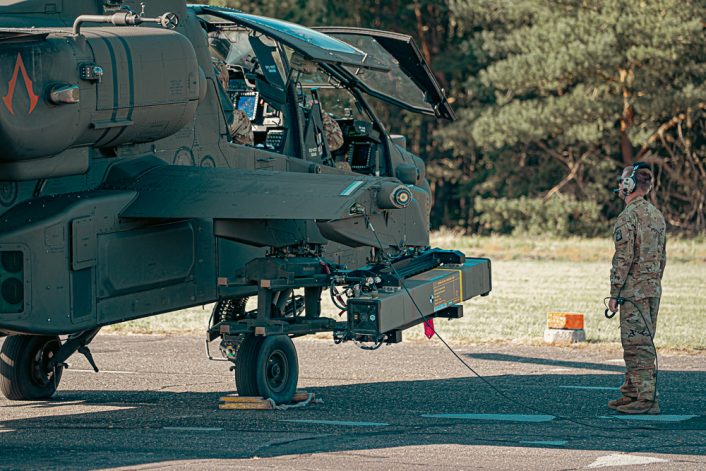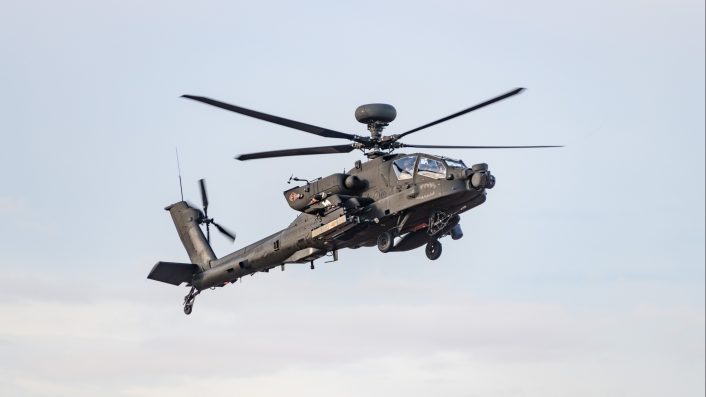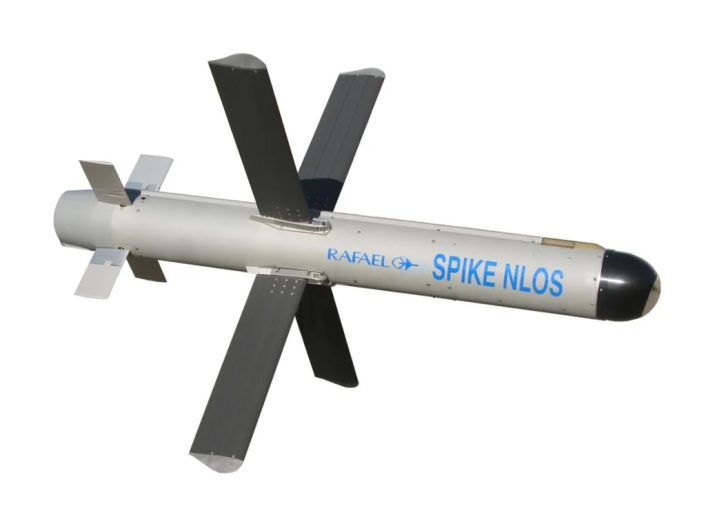AH-64E v6 Apache Guardians fired Spike NLOS missiles at sea-based targets at distances of up to 25 kilometers in Poland.
The U.S. Army has successfully conducted the first European live-fire demonstration of the Spike Non-Line-of-Sight (NLOS) missile from an AH-64E v6 Apache Guardian, marking a milestone in the integration of advanced long-range precision strike capabilities onto the attack helicopter. The joint campaign, organized in cooperation with the Polish Air Force Inspectorate and supported by Rafael Advanced Defense Systems, took place at the Central Air Force Training Range in Ustka, on Poland’s Baltic coast.
The exercise saw U.S. Army AH-64Es from the 12th Combat Aviation Brigade (CAB) firing two Spike NLOS missiles at sea-based targets, striking successfully at ranges of up to 25 kilometers (14 nautical miles), according to the U.S. Army’s statement. Observers from several countries, including senior military representatives and defense officials, were invited to witness the weapon’s long-range precision strike capabilities.
A Historic First
According to service’s press release issued on Aug. 27, 2025, the live-fire test marked the first time that the service has employed the Spike NLOS from the Apache platform in the European theater. While the service did not mention when the test took place, the captions of the photos released on the DVIDS network mention the date as Aug. 27.
The demonstration highlighted the system’s beyond-line-of-sight engagement capabilities in maritime scenarios, noted the service, missions traditionally outside the reach of the Apache’s current missile armament. Moreover, the service added this emphasizes the AH-64E’s capability to meet evolving mission needs, such as maritime and beyond-line-of-sight scenarios.

The integration of the Spike NLOS represents a significant increase in standoff strike options for the Apache. The weapon far exceeds the range of the AGM-114 Hellfire, the Apache’s primary missile, which is generally credited with a maximum reach of about seven nautical miles.
By contrast, the Spike NLOS enables engagement of targets well over three times that distance, significantly enhancing the survivability and lethality of the platform in high-threat environments. Because of this, the Army decided to field the missile as an interim Long Range Precision Munition in 2020.
Multinational Observers
The campaign was attended by observers from more than ten allied nations, according to Rafael, including senior commanders and defense officials, underscoring the significance of the event for NATO’s eastern flank. According to both the U.S. Army and Rafael, the activity demonstrated not only current operational effectiveness but also the future direction of multinational cooperation in precision strike capabilities.
Polish military authorities played a central role in hosting the event. The Ministry of National Defence (MoND), the General Staff of the Polish Armed Forces, and the Inspectorate of the Polish Air Force all participated in the exercise, which has been in the works for a year.

“The successful campaign reflects over a year of close planning and coordination between U.S. and Polish forces, supported by industry partners,” Rafael said in its Aug. 28 press release.
Industry Support and Missile Integration
As the developer and manufacturer of Spike NLOS, Rafael Advanced Defense Systems provided integration support and technical expertise during the campaign. The company emphasized its longstanding partnership with the U.S. Army, and has teamed up with Lockheed Martin to supply the Spike NLOS to the service.
The live-fire demonstrated the maturity of the integration process, showing that the AH-64E v6 platform can effectively employ the missile against sea-based targets at extended ranges. Rafael also underlined its willingness to support the Polish Armed Forces with future capability-building efforts as the country prepares to receive its own AH-64Es, including potential cooperation with the domestic defense industry.
This test followed earlier U.S. Army evaluations of Spike NLOS. In December 2023, a five-day campaign saw eight missiles launched against a variety of ground targets, including a mock-up of a SA-22 surface-to-air missile system, with engagements made at ranges exceeding 16 nautical miles. Those trials also highlighted the weapon’s resilience, including the ability to automatically complete its mission even if communication with the launch aircraft was lost.

AH-64Es of the 101st Airborne Division were also seen carrying Spike NLOS missiles in Iraq in March 2025, although no details were released. Additionally, Apache of the 12th CAB were already spotted with the new weapon in Germany during Exercise Allied Spirit in early 2025.
Implications for Poland’s Future Apache Fleet
Poland is one of the largest future operators of the AH-64E Apache, having committed to the acquisition of 96 helicopters under its Kruk (Raven) requirement. Deliveries are expected to begin in 2028 and continue through 2032, according to Janes. In preparation, Polish crews are already training on leased U.S. Army AH-64D Apache Longbow helicopters.
In fact, since 2024, Polish and U.S. Army aviators worked together to establish Poland’s Apache aviation program. In June, the first three AH-64D Apaches, out of a total of eight, arrived at the 56th Air Base in Inowrocław.
On June 17, 2025, the 🇵🇱Armed Forces inducted the first AH-64D #Apache attack helicopters into service. https://t.co/9U8bwX2NCv
— Poland MOD 🇵🇱 (@Poland_MOD) June 17, 2025
A live-demonstration of the utilization of the AH-64D Apache helicopter supporting a ground unit was also provided by the U.S. Army’s 1st Armored Division Combat Aviation Brigade during a recent event parallel to the Spike NLOS test. A tactical forward arming and refueling point demonstration is also planned.
The demonstration of Spike NLOS in Poland carries particular significance for Warsaw. Senior U.S. and Polish military officials stressed that the integration of the missile onto the Apache enhances rotary-wing aviation by enabling standoff engagements against both land and maritime targets.
For Poland, which will deploy the largest Apache fleet in Europe, the system could become a cornerstone of its future long-range precision strike capabilities. This capability aligns with Warsaw’s ongoing efforts to strengthen national defense and bolster NATO’s collective deterrence along its eastern borders.
According to Janes, the country is considering fielding the weapon on its AH-64s.









